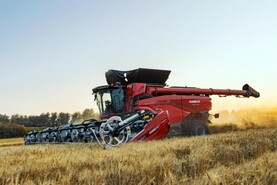While we are now exactly halfway through the harvest, we still have no cattle bought this autumn.
Normally, we start buying bull weanlings around mid-July, but with my bull customer refocusing their business onto steers, or 16-month-old bulls, I am trying to figure out what’s the best way forward for my grassland.
As I mentioned, I see no point in going down the 16-month bull route, with very high grain inputs and no control over the genetic material that I buy in. It would seem there is no alternative but to go down a steer route with a long grazing season and a quick finishing for those forward enough to finish out of the shed. In the meantime, we are continuing to move the bulls we have on-hand as they become fit.
Last week, we got to cut and finish the oilseed rape. We opened up the field on a sunny, breezy Wednesday afternoon and by close of business on Thursday we were finished. I had applied a pod sealant which may or may not have been necessary, but given the forecast I was not willing to risk it. I was pleasantly surprised the moisture was at 9.5%, but the yield was back on last year’s 2t. Based on preliminary figures, it seems to have come in at 1.75t. Given how the crop looked with excellent establishment and good branding, I was mildly disappointed but no more than that. I was relieved to get it finished so smoothly, ahead of what turned out to be very heavy rain. My contractor’s combine, fitted with a hydraulic side knife, worked well and after the fire incident in the winter barley, it had no problems. The winter barley straw is all baled and gone to its local equine market, but again, unlike last year, there was no demand for the rape straw so that was chopped and spread by the combine. It’s an element of the return that will be missing from the profit figure for this year’s harvest.
We still have three crops to harvest: my gluten-free oats, wheat and beans. But we are already “grubbing” the winter barley stubble in preparation for the sowing of winter barley for 2020.






 This is a subscriber-only article
This is a subscriber-only article










SHARING OPTIONS: